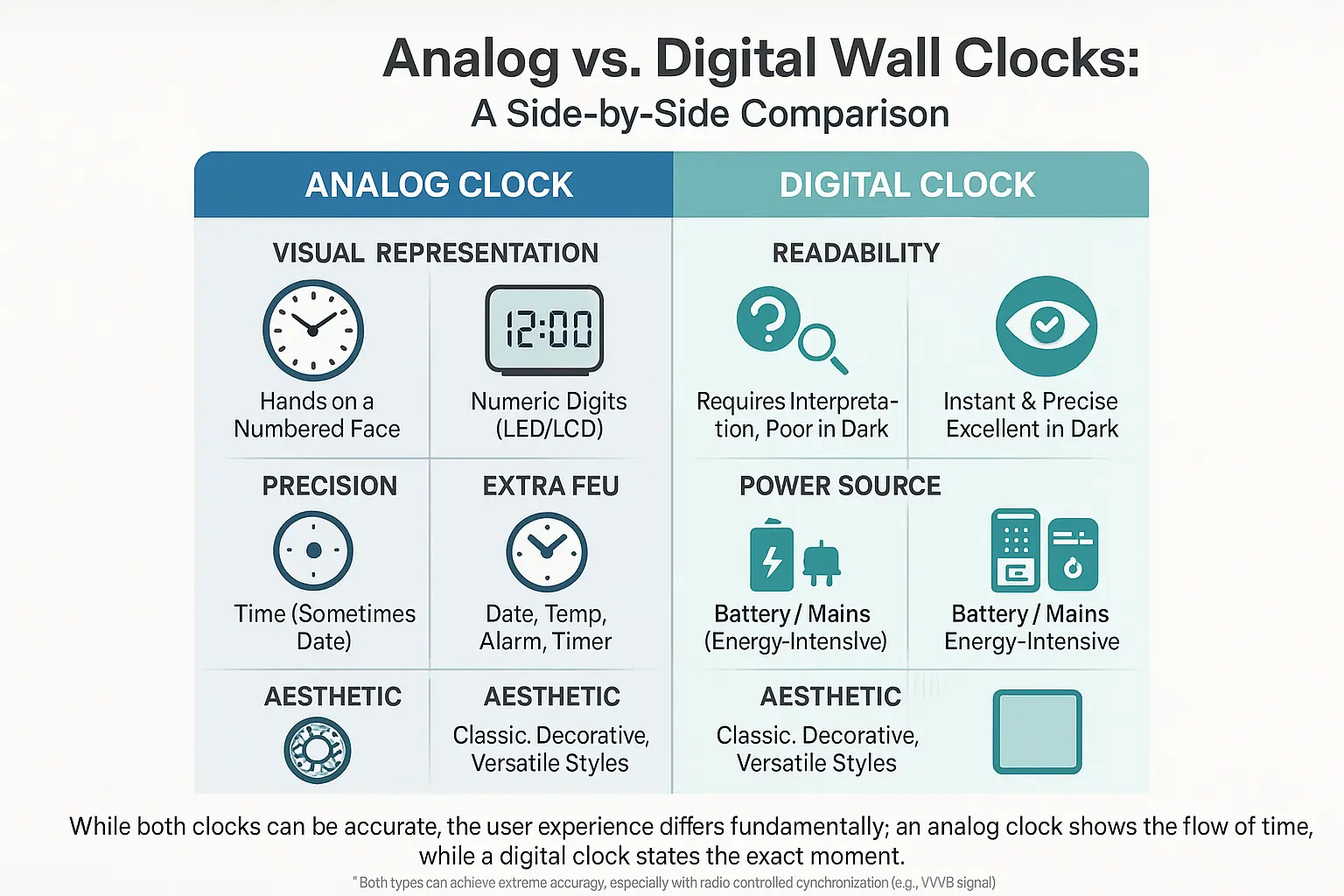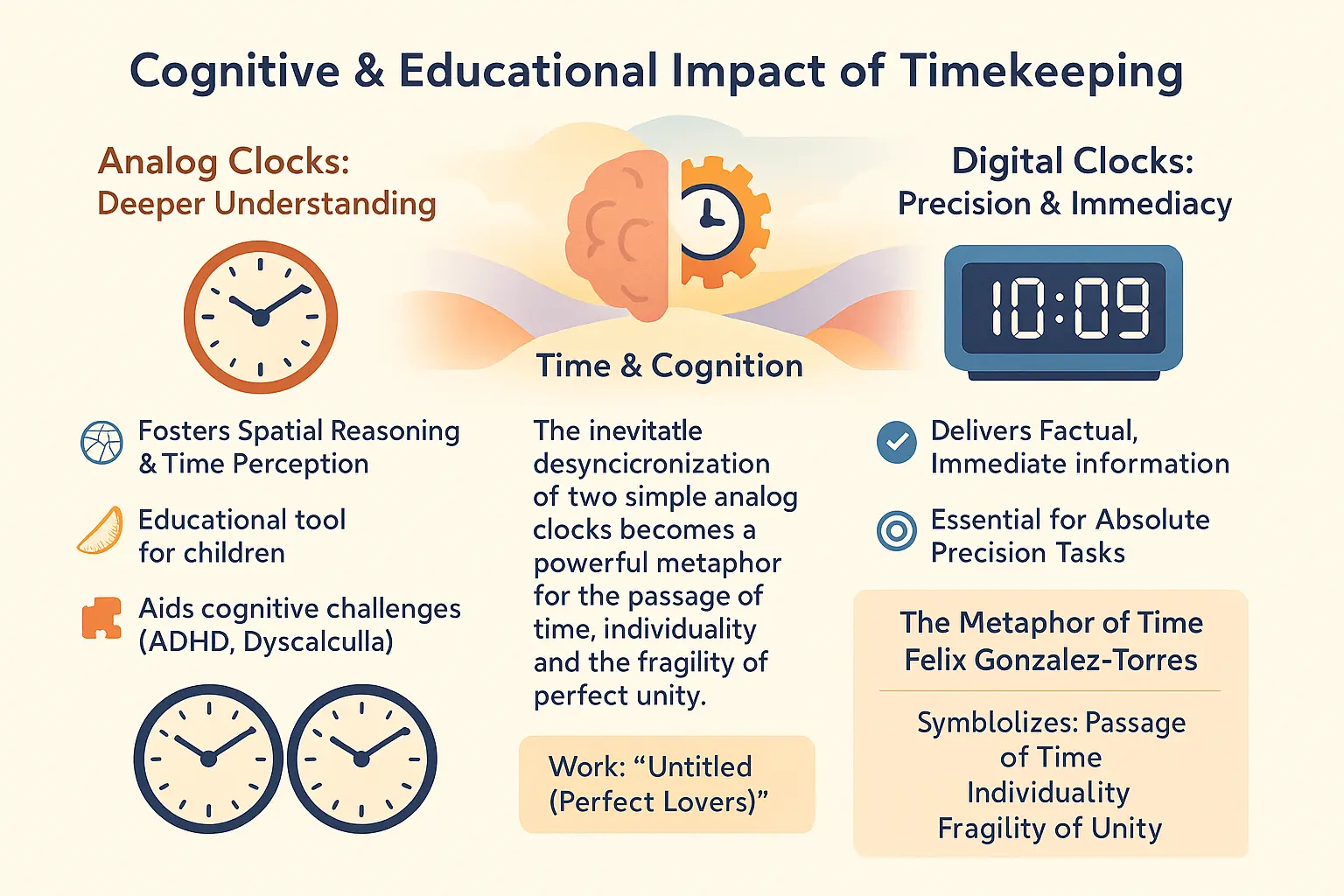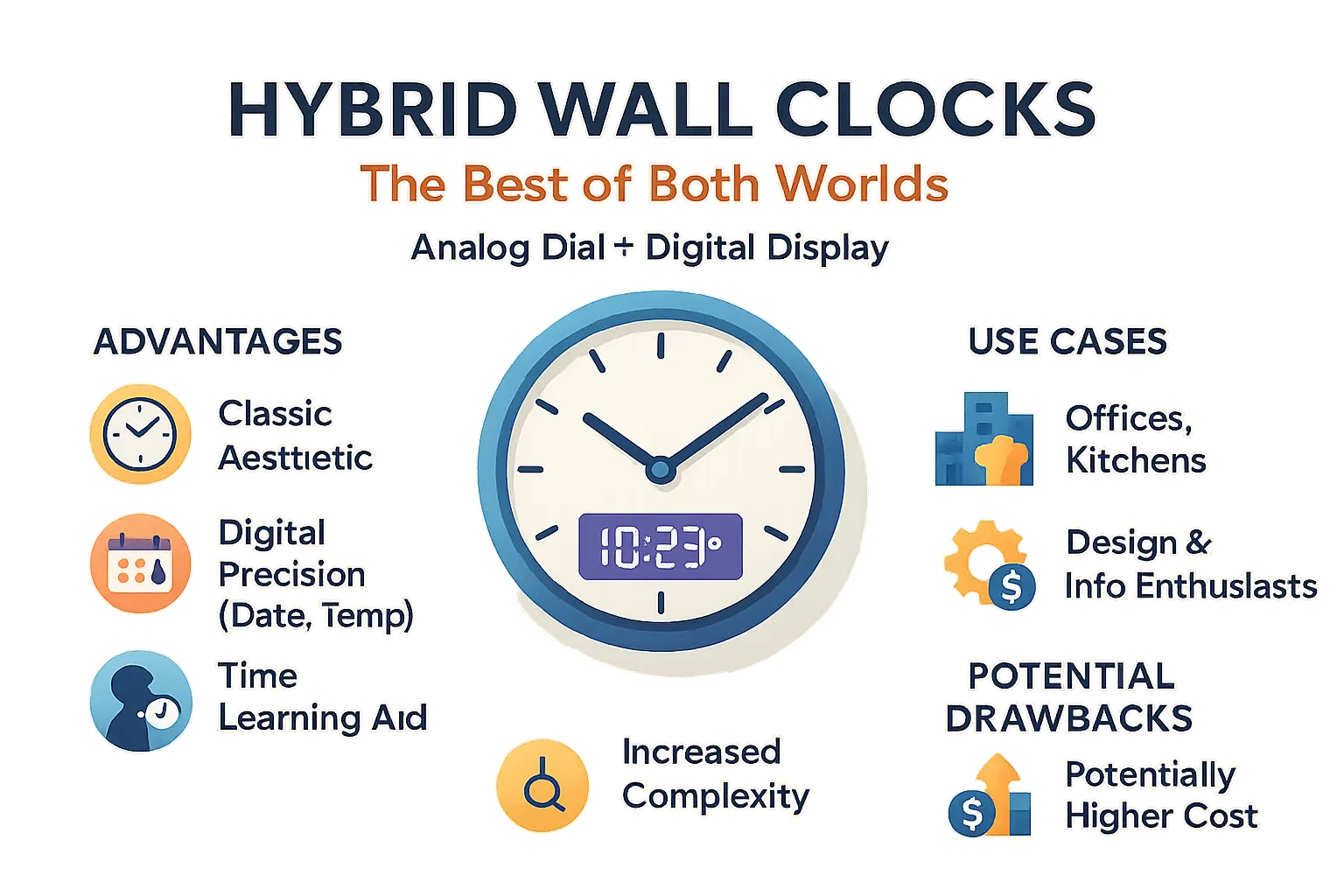Is a wall clock analog or digital?
Wall Clock: Analog or Digital?
Looking to choose between analog and digital wall clocks? The essential takeaway: Analog clocks offer timeless design and educational value, while digital clocks provide instant readability and advanced features like temperature display. Hybrid models merge both, offering precise timekeeping with aesthetic versatility. Both can achieve atomic-level accuracy, ensuring your space balances style, functionality, and precision.
Feeling torn between timeless elegance and tech-savvy precision in your wall clock analog digital comparison? This guide cuts through the noise to reveal how design, functionality, and personal needs shape your perfect timepiece. Discover why vintage charm might outperform LED clarity in key scenarios-or why split-second accuracy could reshape your time perception. Whether outfitting a kitchen or bedroom, our breakdown of atomic precision versus analog warmth simplifies your choice. We'll uncover hidden drawbacks like ticking noises versus energy use, examining how silent mechanisms or lighting affect routines. Every tick or pixel tells a story-discover which fits your lifestyle.
- The classic choice: what is an analog wall clock?
- The modern alternative: what is a digital wall clock?
- Beyond Telling Time: The Cognitive And Educational Impact
- The Best of Both: Are Hybrid Wall Clocks an Option?
- How to choose the right wall clock for your space
Analog vs digital wall clock: understanding the key differences
A wall clock can be analog (with hands) or digital (with numbers). This guide helps you choose based on design, functionality, and user needs.
Core Features
Analog clocks use moving hands on a numbered face. Digital clocks show time with electronic digits. Analog suits classic decor; digital offers precise, feature-rich options.
Functional Differences
Analog displays time through hand positions, requiring interpretation. Digital shows exact numbers instantly. Analog suits continuous time perception; digital benefits quick readings.
Design And User Needs
Analog enhances decor with vintage styles. Digital favors minimalism and functions like alarms or backlighting. Choose analog for low maintenance; digital for silent operation and multifunctionality.
Comparison Table
| Aspect | Analog | Digital |
|---|---|---|
| Design | Classic, decorative | Modern, minimalist |
| Readability | Intuitive from a distance | Exact time at a glance |
| Power | Long-lasting batteries | Electricity or batteries |
| Features | Fewer functions | Alarms, calendars, more |
Opt for analog for ambiance and simplicity. Choose digital for precision and added features.
The classic choice: what is an analog wall clock?
How it works and what it offers
Analog wall clocks use a traditional clock face with hour markers (1–12) and moving hands to display time. Most modern versions rely on quartz mechanisms: a battery powers a circuit that vibrates a quartz crystal at 32,768 Hz, creating precise electrical pulses. These pulses drive a stepping motor, moving gears that rotate the hour, minute, and sometimes second hands. This system balances affordability with accuracy, losing/gaining about 15 seconds monthly under normal conditions.
Their visual design emphasizes cyclical time perception. The smooth, incremental movement of hands (especially in "silent sweep" models) contrasts with digital displays, making them suitable for environments prioritizing aesthetics or educational purposes.
Pros and cons of analog clocks

- Pros:
- Timeless aesthetic: Complements traditional, minimalist, or vintage decors.
- Educational tool: Teaches time-reading skills and visualizes time passage concepts like quarters/halves Wirecutter notes.
- Low visual distraction: Smooth hand movement reduces cognitive overload compared to digital displays.
- Energy efficient: Lasts months/years on single AA batteries.
- Cons:
- Less precise: Requires interpretation, unlike numerical displays.
- Poor night visibility: Needs external lighting for readability.
- Potential noise: Standard models produce audible ticking, though silent sweep mechanisms eliminate this issue.
Analog clocks remain popular for their blend of functionality and decor compatibility. While they lack digital clocks' instant readability, their design flexibility and educational value make them ideal for classrooms, homes, and settings where time visualization matters more than split-second precision.

The modern alternative: what is a digital wall clock?
How it works and what it offers
Digital wall clocks use electronic circuits to display time in numeric format. A quartz oscillator generates precise vibrations converted into electrical pulses, ensuring accurate timekeeping without manual adjustments. Most models use LED or LCD screens, with LED offering brighter visibility but higher energy consumption.
These clocks rely on electricity from outlets or batteries. Unlike analog designs, they show exact time instantly. Advanced versions sync with radio signals for automatic updates, making them ideal for environments requiring precision like classrooms or medical facilities.
Pros and cons of digital clocks
Digital clocks balance practicality with modern design. Let’s explore their key advantages and limitations:
- Pros:
- Immediate readability: Large digital numbers allow quick time checks from distances up to 250 feet.
- Excellent visibility: Backlit displays with adjustable brightness work well in dark rooms, featuring non-glare screens.
- Multifunctional: Many models include temperature, humidity, alarms, or moon phase displays. Some project time onto ceilings.
- Silent operation: No ticking hands, ensuring quiet environments.
- Cons:
- Aesthetic limitations: May feel less warm or struggle to match traditional decor styles.
- Power dependency: Risk of stopping during power outages unless equipped with backup batteries.
- Potential light disturbance: LED glow might disrupt sleep unless dimmed, though modern models often feature ambient light sensors.
These clocks suit users prioritizing accuracy and multifunctionality over decorative appeal. Their digital displays make them particularly effective for time-sensitive settings like offices or hospitals, while smart features cater to tech-savvy consumers.
| Feature | Analog Wall Clock | Digital Wall Clock |
|---|---|---|
| Visual Representation | Hands on a numbered face | Numeric digits on a screen (LED/LCD) |
| Readability | Requires interpretation, poor in the dark | Instant and precise, excellent in the dark |
| Precision | Good, but reading is an estimate. Can be improved with atomic/radio-controlled technology | Highly precise to the second. Often includes atomic/radio-controlled synchronization |
| Extra Features | Generally limited to time-telling (sometimes date) | Often includes date, temperature, alarm, timer, etc. |
| Power Source | Typically battery-powered (long life) | Battery or mains-powered (can be energy-intensive) |
| Aesthetic | Classic, decorative, versatile styles | Modern, functional, tech-oriented |
| Best For | Decorative spaces, traditional settings | High-accuracy needs, multifunctional use |
When comparing precision, both analog and digital clocks achieve remarkable accuracy through radio-controlled technology. These devices synchronize with official time signals like the WWVB signal in North America or DCF77 in Europe, maintaining accuracy within one second over a million years. While analog clocks display time through physical hand movement, digital models present exact numeric values.
"While both clocks can be accurate, the user experience differs fundamentally: an analog clock shows the flow of time, while a digital clock states the exact moment."
Radio-controlled mechanisms work similarly in both types: analog models automatically adjust hands, while digital versions update numeric displays. This eliminates manual adjustments for daylight saving time changes. The key difference lies in time presentation rather than technical precision.
For users prioritizing design, analog clocks often become decorative pieces, whereas digital clocks focus on functional clarity for environments requiring precise time checks. Both types benefit from automated timekeeping, though digital clocks better assist users with visual impairments via larger, backlit displays. Radio-controlled technology originated in 1903 and now powers devices from smartphones to car radios, demonstrating its reliability across both clock types.

Beyond Telling Time: The Cognitive And Educational Impact
Wall clocks aren't just timekeepers-they shape how we perceive time and interact with it. Analog clocks offer a spatial representation of time's passage, while digital clocks provide immediate numerical clarity. This distinction has tangible implications for cognitive development and daily life applications.
Analog Clocks And Spatial Reasoning
Analog clocks require interpreting angles and positions of hands, fostering spatial reasoning skills. Children learning to read analog clocks develop a stronger intuitive grasp of fractions, cycles, and elapsed time estimation. For some individuals with dyscalculia or ADHD, the visual continuity of analog displays can make time management more tangible compared to digital readouts. However, research indicates that people with dyscalculia often struggle specifically with analog clocks due to challenges in processing spatial and numerical sequences.
Digital Clocks: Factual Precision
Digital clocks eliminate interpretation by displaying time numerically. This makes them optimal for environments requiring exactness-like medical facilities or industrial settings. Their simplicity benefits users who need straightforward information without spatial translation, though they lack the contextual time awareness provided by analog motion.
Artistic Perspectives On Time Perception
The cognitive contrast between analog and digital becomes strikingly visible in Felix Gonzalez-Torres' artwork "Untitled (Perfect Lovers)". Two synchronized analog clocks inevitably drift apart as batteries deplete, symbolizing the fragility of unity over time.
The inevitable desynchronization of two simple analog clocks becomes a powerful metaphor for the passage of time, individuality, and the fragility of perfect unity.
As explored in Queer Art Perspectives, this piece transforms timekeeping into a meditation on mortality and connection. The clocks' cyclical renewal through battery replacements mirrors human resilience against inevitable separation. This artistic application highlights how analog clocks uniquely embody time's transient nature compared to digital displays.

The Best of Both: Are Hybrid Wall Clocks an Option?
Ever wondered how to merge timeless design with modern precision? Hybrid wall clocks offer a unique solution. These clocks feature a traditional analog dial with hands, paired with a discreet digital display showing time, date, or temperature. They bridge the gap between classic aesthetics and functional tech, appealing to diverse users.
Why Choose a Hybrid Clock?
- Design Flexibility: Keeps the elegance of analog clocks while adding digital clarity.
- Learning Tool: Helps children compare analog and digital time formats visually.
- Extra Features: Digital segments can show weather, alarms, or schedules without cluttering the dial.
Ideal Use Cases
Hybrid clocks thrive in spaces needing both style and utility. Offices benefit from precise timekeeping and date displays. Kitchens gain readability in low light. Homes blend retro decor with modern convenience. Their dual interface suits users who value nostalgia but rely on digital accuracy.
Considerations
While hybrids merge strengths, they may cost more than single-format clocks. Some models require frequent battery changes due to dual mechanisms. Complexity in design could mean higher maintenance, though advancements minimize this risk. Always check user reviews for reliability before purchasing.
By balancing tradition and innovation, hybrid wall clocks cater to those unwilling to compromise on form or function. Ready to explore if this blend matches your needs? Let’s dive deeper.
How to choose the right wall clock for your space

Selecting between analog and digital wall clocks requires balancing design, functionality, and user needs. While personal taste plays a role, specific environments benefit from tailored features. This guide breaks down optimal choices for different spaces, ensuring your clock serves both practicality and style.
- For the kitchen or office: Digital or hybrid clocks thrive in high-activity zones. Features like atomic timekeeping for automatic adjustments, temperature displays, and programmable timers streamline tasks. Projection models cast the time onto walls or ceilings, ideal for quick checks during cooking or meetings. Look for models with adjustable brightness to avoid glare during focused work. For offices, clocks with calendar functions or alarm settings can improve time management.
- For the living room: Analog clocks often double as statement decor. Silent quartz movements eliminate ticking, preserving tranquility. Materials like brushed metal, matte wood, or mirrored acrylic adapt to modern, rustic, or minimalist themes. Roman numerals or minimalist dials add elegance, while oversized designs create a bold visual impact. Pair with warm lighting to enhance ambiance. Consider clocks with pendulums for a classic touch in traditional spaces.
- For the bedroom: Prioritize noise reduction and sleep-friendly lighting. Analog clocks with silent sweep mechanisms ensure undisturbed rest, while digital options with dimmable displays offer nighttime readability. Avoid blue light in digital models, as it can disrupt circadian rhythms. Hybrid clocks with adjustable brightness combine the best of both worlds for light-sensitive sleepers. Place clocks at eye level for easy visibility without harsh glare.
- For a child’s room: Analog clocks with large, high-contrast numerals teach time-telling skills. Durable materials like shatterproof acrylic or wood withstand playful handling, while colorful designs spark engagement. Consider clocks with interactive elements, such as movable hands for hands-on learning. Themes like animals or space can make learning fun and align with room decor.
- For seniors or visually impaired users: Large digital clocks with high-contrast screens (e.g., black text on white) guarantee clarity. Backlit displays and oversized digits reduce eye strain, while tactile buttons simplify adjustments. Look for models with voice-assisted features (if available) for auditory time updates. These clocks are often found in specialty stores or online retailers focusing on accessibility tools.
When deciding between analog and digital clocks, always weigh the user’s habits against the environment. A digital model’s tech-forward design might thrive in a home office, while an analog piece could anchor a living room’s decor. For shared spaces, hybrid options balance tradition and innovation. By aligning functionality with aesthetics, you’ll select a clock that blends utility with lasting appeal-transforming a simple timekeeper into a purposeful design element.
Choosing between analog and digital wall clocks depends on aesthetics, functionality, and needs. Analog offers timeless charm and educational value; digital provides precision and features like alarms. Hybrid options merge both. Prioritize space, users, and purpose to make your clock more than a timekeeper in this wall clock analog digital comparison. (59 words)
FAQ
Which is better: digital or analog clocks?
The choice between digital and analog clocks depends on personal preferences and needs. Digital clocks excel in immediate readability, precise timekeeping, and multifunctionality (e.g., alarms, temperature displays). They’re ideal for environments where time checks must be quick, like kitchens or offices. Analog clocks, however, offer a timeless aesthetic and help users visualize time as a continuous flow, which can improve time management and spatial reasoning. They’re often preferred for educational purposes, especially for teaching children to tell time.
Are analog clocks becoming outdated?
While digital clocks dominate modern life, analog clocks remain far from obsolete. They’re cherished for their decorative value, educational benefits, and cognitive advantages (e.g., aiding individuals with ADHD). Many analog clocks now use silent-sweep mechanisms to reduce noise, addressing past drawbacks. However, younger generations may rely less on analog clocks due to digital prevalence, though they’re still widely used in schools, homes, and art.
Why do some clocks not tick?
Modern analog clocks often use "silent-sweep" technology to eliminate the traditional ticking sound. This design replaces the jerky second-hand movement with smooth, continuous motion, reducing noise. The innovation, highlighted in product reviews like Wirecutter’s, appeals to those in quiet environments, such as bedrooms or offices, while retaining the classic analog look.
Do analog clocks benefit individuals with ADHD?
Yes, analog clocks can be particularly helpful for people with ADHD. The visual representation of time (e.g., watching the minute hand move) fosters a tangible understanding of time passing, aiding focus and time management. This spatial awareness helps individuals with ADHD estimate durations (e.g., "half an hour") and plan tasks, unlike digital clocks, which present time as abrupt numerical shifts.
Why is digital considered superior to analog?
Digital clocks outperform analog ones in clarity, precision, and functionality. They display time instantly, often with options to adjust brightness for low-light settings, and include features like alarms, timers, and weather updates. Their silent operation (no ticking) and low cognitive effort for time reading make them practical for fast-paced environments. However, analog clocks retain unique advantages for education and spatial learning.
What percentage of Americans can read an analog clock?
While exact statistics vary, most Americans-especially older generations-can read analog clocks. However, younger individuals raised in a digital-first world may struggle with analog timekeeping. Schools still teach analog literacy, but declining reliance on analog clocks in daily life means proficiency is increasingly tied to exposure and necessity.
What are the downsides of analog clocks?
Analog clocks have a few limitations: - Poor low-light visibility unless retrofitted with glow-in-the-dark markers. - Less precision: Reading time requires interpretation (e.g., estimating "quarter past"). - Potential noise: Traditional ticking mechanisms can be distracting, though silent-sweep models exist. - Limited features: Unlike digital clocks, they typically lack alarms, date displays, or temperature readings.
Do individuals with ADHD find clock reading challenging?
People with ADHD may find analog clocks easier for understanding time as a visual continuum, aiding task prioritization. However, some might prefer digital clocks for their instant readability, reducing the mental effort required to interpret time. Both types have merits-digital for clarity, analog for fostering time-awareness strategies tailored to ADHD needs.


